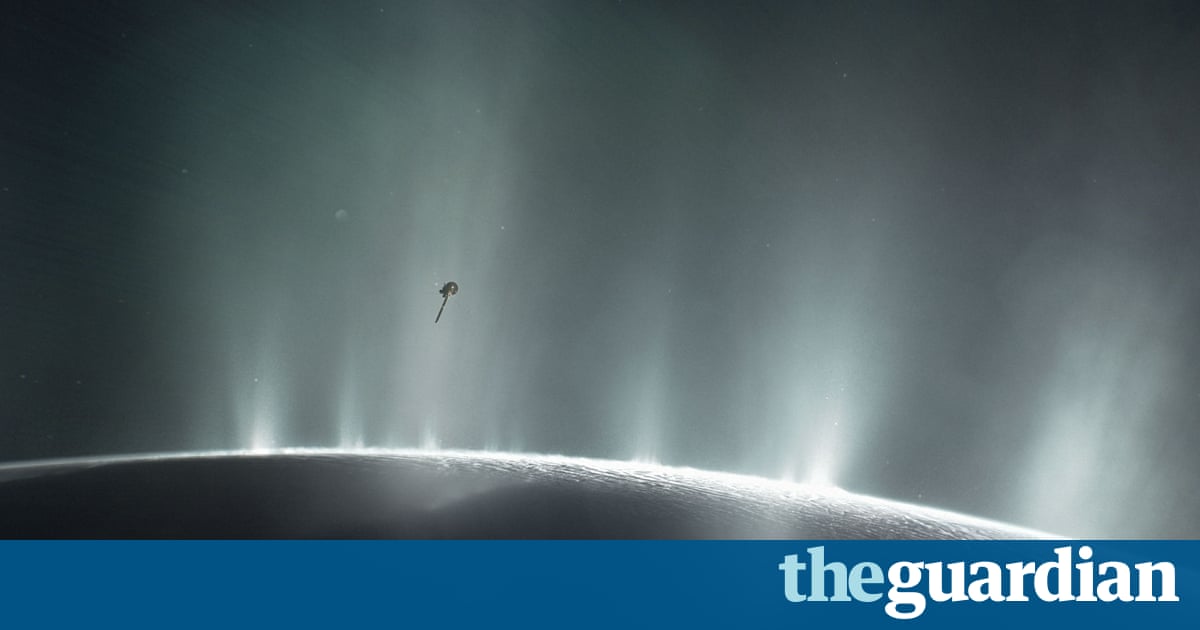Scientists say discovery of ingredients for life on Saturns moon Enceladus is bittersweet as spacecraft prepares to end 20-year mission

Could there be life in our own solar system?
This is the question posed by the discovery of hydrogen gas erupting in plumes from Saturns moon Enceladus, indicating the likely existence of an energy supply for microbial life.
The presence of hydrogen, detected by the Cassini spacecraft and announced by Nasa on Thursday, is seen as tantalising evidence that in the ocean beneath the moons icy surface chemical reactions are taking place that are strikingly similar to those that occur at hydrothermal vents on the Earths ocean floors.
In the fissures of the Earths oceans, a process called serpentinisation produces hydrogen when salty water reacts with hot rocks. This is what allows microbes, which use hydrogen as a source of chemical energy, to thrive in the ocean depths, raising the question of whether equivalent biology might have emerged on Enceladus.
Although we cant detect life, weve found that theres a food source there for it. It would be like a candy store for microbes, said Hunter Waite, programme director for the space science and engineering division at the Southwest Research Institute in San Antonio and lead author of the Cassini study.
Based on the observed concentration of the hydrogen in the plumes, scientists calculate that the hydrothermal activity on Enceladus produces more than enough energy to sustain a hypothetical colony of alien microbes.
Enceladus is a mysterious enigmatic object that now shows it has all of the ingredients for life, which is why scientists are so jazzed about the discovery, said Sara Seager, a planetary scientist at MIT. Hydrogen gas sets up a way for life to extract energy from chemistry a main way microbes exploit energy to live here on Earth.
However, the discovery of an available food source poses a new puzzle: why, if something is alive on Enceladus, is it not consuming all the available fuel? The surplus of hydrogen could be an indication of the absence of life, or of a very inactive microbe lurking in the oceans depths.
Until 11 years ago, Saturns tiny moon, with a diameter about the length of England, was regarded as an unremarkable object. But then Cassini discovered plumes coming from its south pole, indicating the presence of liquid water, often the first item on the checklist when seeking out the places in the universe that might host life.
Since then, scientists have ticked off some of the other chemical elements thought to be required carbon, nitrogen, oxygen, and now hydrogen (the other two, phosphorus and sulphur, have yet to be detected but are almost certainly present).
Prof Andrew Coates, a Cassini scientist based at University College Londons Mullard Space Science Laboratory, said: There are four things you need for life: liquid water, the right chemistry, a source of energy, and enough time for life to develop. This gives that chemical imbalance, that gives you a source of energy.
As Saturn moves in its orbit, the plumes have been observed to vary in intensity and it is not known whether conditions would have been stable enough for a chain of reactions leading to the emergence of life to occur uninterrupted. On Earth, it took millions of years after favourable conditions appeared for life to spark into existence. We dont know if there has been enough time or not on Enceladus, said Coates.
With the first three of the four prerequisites ticked off, Coates now considers Enceladus, along with Jupiters moon Europa, to be the most likely place in the solar system to discover microbial life today.
Coates describes this as a bittersweet realisation. The results, frustratingly, come just as Cassini is running out of fuel after 20 years in space. In September, Cassini will pass through the inner edge of the ring system and plunge into Saturns atmosphere where the probe will be vaporised in what Nasa describes as the missions grand finale. With no Saturn missions scheduled, it will be at least a decade before another Enceladus flyby, let alone a landing.
The great mystery of whether humans are alone in the universe and what other lifeforms might look like from basic microbes to advanced civilisations remains out of reach for now. But Cassinis findings add to scientists growing confidence that there are places beyond Earth where life might find a viable home and that some of them are probably within reach of a spacecraft.
Read more: http://www.theguardian.com/us
The post Spacecraft discovers possibility of alien life, then runs out of fuel appeared first on AlienVirals.com - Latest Alien & UFO News.
source http://www.alienvirals.com/spacecraft-discovers-possibility-of-alien-life-then-runs-out-of-fuel/

No comments:
Post a Comment